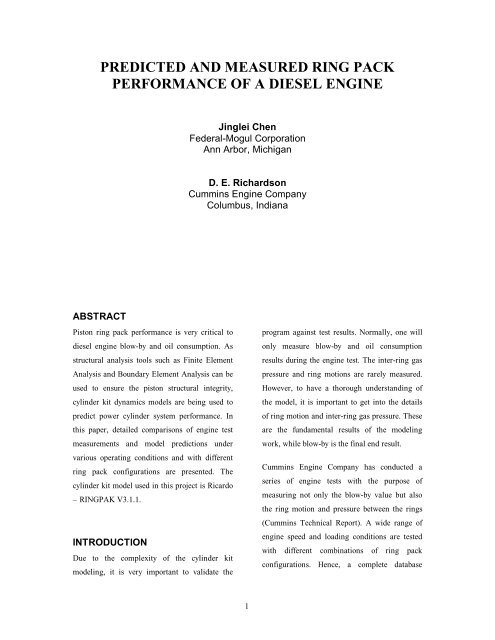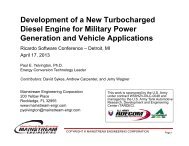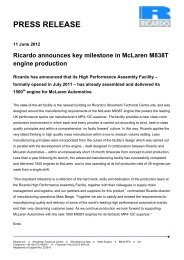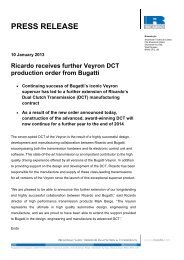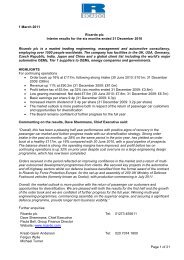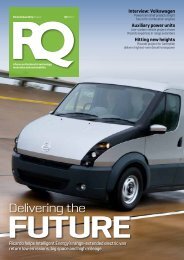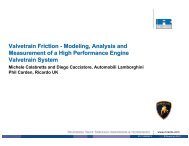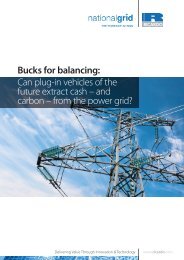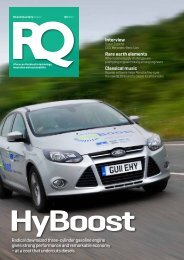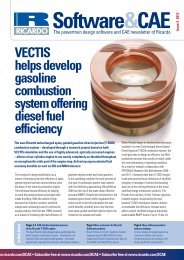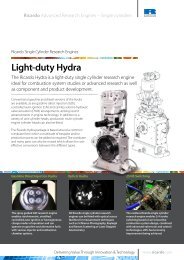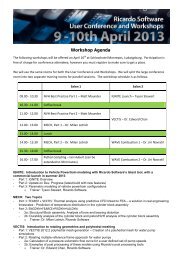predicted and measured ring pack performance of a diesel ... - Ricardo
predicted and measured ring pack performance of a diesel ... - Ricardo
predicted and measured ring pack performance of a diesel ... - Ricardo
You also want an ePaper? Increase the reach of your titles
YUMPU automatically turns print PDFs into web optimized ePapers that Google loves.
PREDICTED AND MEASURED RING PACK<br />
PERFORMANCE OF A DIESEL ENGINE<br />
Jinglei Chen<br />
Federal-Mogul Corporation<br />
Ann Arbor, Michigan<br />
D. E. Richardson<br />
Cummins Engine Company<br />
Columbus, Indiana<br />
ABSTRACT<br />
Piston <strong>ring</strong> <strong>pack</strong> <strong>performance</strong> is very critical to<br />
<strong>diesel</strong> engine blow-by <strong>and</strong> oil consumption. As<br />
structural analysis tools such as Finite Element<br />
Analysis <strong>and</strong> Boundary Element Analysis can be<br />
used to ensure the piston structural integrity,<br />
cylinder kit dynamics models are being used to<br />
predict power cylinder system <strong>performance</strong>. In<br />
this paper, detailed comparisons <strong>of</strong> engine test<br />
measurements <strong>and</strong> model predictions under<br />
various operating conditions <strong>and</strong> with different<br />
<strong>ring</strong> <strong>pack</strong> configurations are presented. The<br />
cylinder kit model used in this project is <strong>Ricardo</strong><br />
– RINGPAK V3.1.1.<br />
INTRODUCTION<br />
Due to the complexity <strong>of</strong> the cylinder kit<br />
modeling, it is very important to validate the<br />
program against test results. Normally, one will<br />
only measure blow-by <strong>and</strong> oil consumption<br />
results du<strong>ring</strong> the engine test. The inter-<strong>ring</strong> gas<br />
pressure <strong>and</strong> <strong>ring</strong> motions are rarely <strong>measured</strong>.<br />
However, to have a thorough underst<strong>and</strong>ing <strong>of</strong><br />
the model, it is important to get into the details<br />
<strong>of</strong> <strong>ring</strong> motion <strong>and</strong> inter-<strong>ring</strong> gas pressure. These<br />
are the fundamental results <strong>of</strong> the modeling<br />
work, while blow-by is the final end result.<br />
Cummins Engine Company has conducted a<br />
series <strong>of</strong> engine tests with the purpose <strong>of</strong><br />
measu<strong>ring</strong> not only the blow-by value but also<br />
the <strong>ring</strong> motion <strong>and</strong> pressure between the <strong>ring</strong>s<br />
(Cummins Technical Report). A wide range <strong>of</strong><br />
engine speed <strong>and</strong> loading conditions are tested<br />
with different combinations <strong>of</strong> <strong>ring</strong> <strong>pack</strong><br />
configurations. Hence, a complete database<br />
1
consisting <strong>of</strong> inter-<strong>ring</strong> gas pressures, <strong>ring</strong><br />
motions, <strong>and</strong> blow-by results is available. This<br />
database is ideal for benchmarking different<br />
cylinder kit models/programs.<br />
The validation results presented in this paper are<br />
part <strong>of</strong> the joint cylinder kit modeling project<br />
carried out by the Cummins Engine Company<br />
<strong>and</strong> Federal-Mogul Corporation. Overall six<br />
different programs, commercial or universitydeveloped<br />
codes, have been evaluated. <strong>Ricardo</strong>-<br />
RINGPAK is one <strong>of</strong> these programs. Two sets <strong>of</strong><br />
results from RINGPAK are presented in this<br />
paper. The first set <strong>of</strong> results was generated<br />
without any calibration work. The second set <strong>of</strong><br />
results was obtained by changing only one<br />
parameter according to the engine running<br />
conditions. Further, the new bore distortion<br />
feature implemented in RINGPAK v 3.1.1 [1]<br />
has also been used in the second iteration.<br />
A significant amount <strong>of</strong> work has been done<br />
developing <strong>and</strong> validating cylinder kit models [2-<br />
6]. Usually the focus <strong>of</strong> validation will be on oil<br />
consumption <strong>and</strong> blow-by predictions. Very few<br />
papers deal with inter-<strong>ring</strong> gas pressure [6] <strong>and</strong><br />
<strong>ring</strong> motion validation due to the difficulty <strong>of</strong><br />
obtaining such detail measurement data. This<br />
work is quite unique in its attempt to have a<br />
complete review <strong>of</strong> the simulation program with<br />
detailed fundamental test data.<br />
Experimental Setup<br />
The experimental work was carried out by<br />
Cummins Engine Company. The tests were<br />
conducted with the intention <strong>of</strong> improving<br />
analytical tools – cylinder kit models. Overall<br />
eight <strong>ring</strong> <strong>pack</strong> configurations have been tested<br />
at different engine operating conditions.<br />
With one <strong>of</strong> the cylinders in the engine<br />
instrumented, the following measurements were<br />
taken in addition to the blow-by values.<br />
• Inter-<strong>ring</strong> Pressure – 2 nd l<strong>and</strong>, Major <strong>and</strong><br />
Minor thrust. (Faulty Transducer)<br />
• Ring motion – Top <strong>and</strong> 2 nd <strong>ring</strong>s, Major <strong>and</strong><br />
Minor thrust; Oil <strong>ring</strong>, Major thrust. (Motion<br />
Sensors mounted on the sides <strong>of</strong> grooves)<br />
• Cylinder pressure – St<strong>and</strong>ard measurement<br />
More details on the tests <strong>and</strong> instrumentation can<br />
be found in the Cummins Technical Report.<br />
RINGPAK Model<br />
To construct a RINGPAK model input set, one<br />
needs to have information on engine operating<br />
conditions, piston l<strong>and</strong> <strong>and</strong> groove dimensions,<br />
<strong>ring</strong> dimensions, cylinder gas pressure <strong>and</strong> gas<br />
temperatures, temperatures <strong>of</strong> piston <strong>and</strong> <strong>ring</strong>s,<br />
surface <strong>and</strong> material properties, lubrication oil<br />
properties, liner distortion or thermal expansion<br />
<strong>of</strong> <strong>ring</strong>s <strong>and</strong> piston, etc. These items are obtained<br />
through drawings, material specifications,<br />
measurement data, <strong>and</strong> reasonable estimations or<br />
extrapolations. Also, there are a few parameters<br />
in the RINGPAK program that are so-called<br />
calibration factors – parameters that can be<br />
changed to improve the match between model<br />
predictions <strong>and</strong> test data. Most <strong>of</strong> these variables<br />
are determined according to Federal-Mogul <strong>and</strong><br />
Cummins experience on using the RINGPAK<br />
program. RINGPAK model is based mainly on<br />
mathematical models rather than empirical<br />
relations. Most <strong>of</strong> the input parameters in the<br />
2
<strong>Ricardo</strong> model have physical significance. Hence<br />
one does not need to rely heavily on the<br />
empirical coefficients.<br />
Results from five case studies are discussed in<br />
this paper, the configurations <strong>of</strong> which are<br />
summarized in the following table.<br />
Table One: Cases Simulated with RINGPAK<br />
Case Engine<br />
speed<br />
Load Ring 1<br />
Twist<br />
Ring2<br />
Twist<br />
Gap ratio<br />
R1 : R2<br />
1 Medium Full + + 1:3<br />
2 Medium Full + - 1:1<br />
3 Low Partial + - 1:1<br />
4 Low Full N + 1:1<br />
5 High Full + - 1:3<br />
Note: + positive twist, - negative twist, N no twist.<br />
All the simulations were run on a HP C160 Unix<br />
workstation. Typical running time is between 20<br />
to 35 minutes.<br />
Results <strong>and</strong> Discussions<br />
There are two kinds <strong>of</strong> results that can be<br />
obtained from the RINGPAK program. One <strong>of</strong><br />
the two are results such as blow-by, <strong>and</strong> oil<br />
consumption, which are critical end results that<br />
people want to know. The other kind <strong>of</strong> results<br />
are more detail-oriented such as inter-<strong>ring</strong><br />
pressure traces, <strong>ring</strong> axial motions, <strong>ring</strong> twist etc.<br />
These results are more useful for people to<br />
underst<strong>and</strong> the modeling fundamentals <strong>of</strong> the<br />
program. Hence, both kinds <strong>of</strong> results are<br />
important for the model evaluation <strong>and</strong><br />
validation.<br />
Blow-by<br />
Shown in Figure One are the blow-by<br />
predictions <strong>and</strong> the corresponding measurement<br />
data. As can be seen, <strong>predicted</strong> blow-by values<br />
are fairly close to the corresponding <strong>measured</strong><br />
data except that <strong>of</strong> case 1. For case 1 the blowby<br />
prediction is significantly higher than the test<br />
measurement. More importantly, it does not<br />
follow the trend <strong>of</strong> the measurement. However,<br />
almost all programs evaluated by Federal-Mogul<br />
<strong>and</strong> Cummins tend to over predict the blow-by<br />
for case 1. Further, as shown in a later section,<br />
RINGPAK gives very good predictions <strong>of</strong> inter<strong>ring</strong><br />
pressure <strong>and</strong> <strong>ring</strong> motions for case 1. Hence,<br />
there is a possibility that the test data for case 1<br />
might not be accurate. Overall, one can conclude<br />
that blow-by predictions obtained through<br />
RINGPAK simulation are satisfactory.<br />
Inter-<strong>ring</strong> pressure <strong>and</strong> <strong>ring</strong> motion<br />
Two sets <strong>of</strong> results <strong>of</strong> inter-<strong>ring</strong> pressure <strong>and</strong> <strong>ring</strong><br />
motions are presented in this paper. The first set<br />
<strong>of</strong> results (iteration 1) was obtained without any<br />
attempt to improve the correlation. In the second<br />
iteration, the new bore distortion feature <strong>of</strong> the<br />
RINGPAK program was used. Further, the <strong>ring</strong><br />
groove surface properties were also modified to<br />
reflect the worn engine conditions. RINGPAK is<br />
a 2-D program <strong>and</strong> no piston tilt effects are<br />
considered in this project. In Figures Two to<br />
Eleven <strong>ring</strong> motion a <strong>and</strong> b <strong>of</strong> the test results<br />
refer to measurements in Major <strong>and</strong> Minor thrust<br />
sides, while <strong>ring</strong> motion a <strong>and</strong> b <strong>of</strong> the<br />
simulation results are locations <strong>of</strong> <strong>ring</strong> OD <strong>and</strong><br />
ID. In all cases the “tuning/calibration”<br />
parameters are kept the same.<br />
Inter-<strong>ring</strong> pressure<br />
Overall, for results <strong>of</strong> iteration 1, the <strong>predicted</strong><br />
peak 2 nd l<strong>and</strong> pressures are quite close to the<br />
3
measurements. However, the <strong>predicted</strong> pressure<br />
traces do not always closely follow the <strong>measured</strong><br />
pressure traces, especially in case 5. The pressure<br />
results from the second iteration provide much<br />
better match with the test data. In all cases, the<br />
<strong>predicted</strong> pressure traces are much closer to the<br />
<strong>measured</strong> pressure curves throughout the entire<br />
engine cycle. Overall, the peaks are also quite<br />
close to <strong>measured</strong> data in the second iteration.<br />
Only in case 4, the pressure prediction <strong>of</strong><br />
iteration 2 seems worse than that <strong>of</strong> iteration 1.<br />
However, a close examination <strong>of</strong> the pressure<br />
trace shows that the pressure trace is actually<br />
better except the region in the vicinity <strong>of</strong> the<br />
peak pressure.<br />
Ring motions<br />
Axial motions <strong>of</strong> all three <strong>ring</strong>s are plotted along<br />
with the corresponding pressure traces in Figures<br />
Two to Eleven. Due to the improved pressure<br />
trace prediction, the overall <strong>predicted</strong> <strong>ring</strong><br />
motions <strong>of</strong> iteration 2 agree better with the<br />
measurements than those <strong>of</strong> iteration 1. Ring<br />
motion results from iteration 2 are summarized<br />
as follows. In case 1, all <strong>predicted</strong> <strong>ring</strong> motions<br />
are very close to the measurements. Only the oil<br />
<strong>ring</strong> lifting near the Fi<strong>ring</strong> TDC is later <strong>and</strong><br />
lifting period is shorter. This is also true for<br />
cases 3 <strong>and</strong> 4. For case 2, the simulation predicts<br />
that the top <strong>ring</strong> lifts <strong>and</strong> stays at the top <strong>of</strong> the<br />
<strong>ring</strong> groove while the measurement shows that<br />
top <strong>ring</strong> is flutte<strong>ring</strong>. The 2 nd <strong>and</strong> oil <strong>ring</strong> motion<br />
predictions are quite good except an extra lift <strong>of</strong><br />
the oil <strong>ring</strong> near the end <strong>of</strong> the intake stroke. The<br />
simulation shows that the top <strong>ring</strong> lifts at the<br />
same time as the measurement in case 3.<br />
However the top <strong>ring</strong> goes down earlier due to<br />
the lower <strong>predicted</strong> 2 nd l<strong>and</strong> pressure. The 2 nd lift<br />
<strong>of</strong> the top <strong>ring</strong> du<strong>ring</strong> the exhaust stroke has also<br />
been captured by RINGPAK simulation. In case<br />
4, the top <strong>ring</strong> lifts earlier due to the higher<br />
<strong>predicted</strong> inter-<strong>ring</strong> pressure, while the 2 nd <strong>ring</strong><br />
<strong>and</strong> oil <strong>ring</strong> predictions are good. One important<br />
<strong>ring</strong> motion features <strong>of</strong> case 5 is the 2 nd <strong>ring</strong> lift<br />
(flutte<strong>ring</strong>) right before FTDC. This is not<br />
captured by the RINGPAK model. The <strong>predicted</strong><br />
top <strong>ring</strong> <strong>and</strong> oil <strong>ring</strong> motions are close to the<br />
measurement in case 5.<br />
Conclusions<br />
♦ RINGPAK predictions on engine blow-by<br />
correlate well with the measurements in<br />
most cases.<br />
♦ Overall, the inter-<strong>ring</strong> pressure calculations<br />
are quite close to the <strong>measured</strong> pressure<br />
traces. It has been noticed that a small<br />
difference in pressure predictions can<br />
sometime cause completely different <strong>ring</strong><br />
motions.<br />
♦ Many <strong>of</strong> the actual <strong>ring</strong> motion<br />
characteristics have been captured in the<br />
RINGPAK simulations. However, there are<br />
some discrepancies between the simulations<br />
<strong>and</strong> measurements.<br />
♦ RINGPAK has been found to be one <strong>of</strong> the<br />
best programs available on the market. It<br />
produces reasonably good results without<br />
requi<strong>ring</strong> too much effort on “tuning” or<br />
calibrating the model.<br />
4
Recommendations<br />
It has been found through the evaluation process<br />
that all <strong>ring</strong> <strong>pack</strong> <strong>performance</strong> simulation<br />
programs including RINGPAK have areas that<br />
need to be further improved. Indeed, most <strong>of</strong> the<br />
program developers have detailed plans to<br />
develop <strong>and</strong> implement new features. Giving the<br />
complexity <strong>of</strong> the model, it is very critical for<br />
users to validate these new features. The<br />
developers should also commit adequate<br />
resources to the continuation <strong>of</strong> the program<br />
development.<br />
ACKNOWLEDGEMENTS<br />
The first author wants to express his great<br />
appreciation toward the Cummins Engine<br />
Company for conducting this series <strong>of</strong> engine<br />
tests without which this evaluation project will<br />
not be possible.<br />
REFERENCES<br />
1. PISTON RINGPACK ANALYSIS –<br />
Documentation/User’s manual Version 3.1.1,<br />
1999.<br />
2. Namazian, M., <strong>and</strong> Heywood, J. B., “Flow<br />
in the Piston-Cylinder-Ring Crevices <strong>of</strong> a Spark-<br />
Ignition Engine: Effect on Hydrocarbon<br />
Emissions, Efficiency <strong>and</strong> Power,” SAE Paper<br />
820088, 1982.<br />
3. Gulwadi, S. D., “A Mixed Lubrication <strong>and</strong><br />
Oil Transport Model for Piston Rings Using a<br />
Mass Conservation Algorithm,” ASME Journal<br />
<strong>of</strong> Enginee<strong>ring</strong> for Gas Turbines <strong>and</strong> Power,<br />
Vol. 120, 1998, pp.199-208.<br />
4. Gulwadi, S. D., “Analysis <strong>of</strong> Tribological<br />
Performance <strong>of</strong> a Piston Ring Pack,” to be<br />
presented at the STLE/ASME International<br />
Tribology Conference to be held in Oct. 1999.<br />
Under review for publication in Tribology<br />
Transactions.<br />
5. Kuo, T., et al., “Calculation <strong>of</strong> Flow in the<br />
Piston-Cylinder-Ring Crevices <strong>of</strong> a<br />
Homogeneous-Charge Engine <strong>and</strong> Comparison<br />
with Experiment,” SAE Paper 890838, 1989.<br />
6. Richardson, D. E., “Comparison <strong>of</strong><br />
Measured <strong>and</strong> Theoretical Inter-<strong>ring</strong> Gas<br />
Pressure on a Diesel engine,” SAE Paper<br />
961909, 1996.<br />
5
0.0<br />
<strong>Ricardo</strong> Simulation<br />
Test Data<br />
0.0<br />
0.0<br />
0.0<br />
0.0<br />
0.0<br />
0.0<br />
0.0<br />
0.0<br />
case1 case2 case3 case4 case5<br />
Figure One: Blow-by Predictions <strong>and</strong> Measurements<br />
6
Comparions <strong>of</strong> Inter-Ring Gas Pressure <strong>and</strong> Ring Motion<br />
Predicted Ring Motion "a"<br />
Predicted Ring Motion "b"<br />
Actual Ring Motion "a"<br />
Actual Ring Motion "b"<br />
Cylinder Pressure - Model<br />
Predicted Inter-<strong>ring</strong> Pressure<br />
Cylinder Pressure<br />
Actual Inter-Ring Pres.<br />
24<br />
16<br />
8<br />
Pressure<br />
Ring Motion (Up/Down)<br />
Up<br />
Down<br />
Up<br />
Down<br />
Up<br />
Oil<br />
Ring<br />
Down<br />
-24<br />
-360 -270 -180 -90 0 90 180 270 360<br />
Crank Angle (degree)<br />
0<br />
Top<br />
Ring<br />
-8<br />
2nd<br />
Ring<br />
-16<br />
Figure Two: Inter-<strong>ring</strong> Pressure <strong>and</strong> Ring Motion Case 1 – Iteration 1<br />
Comparions <strong>of</strong> Inter-Ring Gas Pressure <strong>and</strong> Ring Motion<br />
Predicted Ring Motion "a"<br />
Predicted Ring Motion "b"<br />
Actual Ring Motion "a"<br />
Actual Ring Motion "b"<br />
Cylinder Pressure - Model<br />
Predicted Inter-<strong>ring</strong> Pressure<br />
Cylinder Pressure<br />
Actual Inter-Ring Pres.<br />
24<br />
16<br />
8<br />
Pressure<br />
Up<br />
Down<br />
Up<br />
Down<br />
Up<br />
Oil<br />
Ring<br />
Down<br />
-24<br />
-360 -270 -180 -90 0 90 180 270 360<br />
Crank Angle (degree)<br />
0<br />
Top<br />
Ring<br />
-8<br />
-16<br />
2nd<br />
Ring<br />
Figure Three: Inter-<strong>ring</strong> Pressure <strong>and</strong> Ring Motion Case 1 – Iteration 2<br />
7
Comparions <strong>of</strong> Inter-Ring Gas Pressure <strong>and</strong> Ring Motion<br />
Predicted Ring Motion "a"<br />
Predicted Ring Motion "b"<br />
Actual Ring Motion "a"<br />
Actual Ring Motion "b"<br />
Cylinder Pressure - Model<br />
Predicted Inter-<strong>ring</strong> Pressure<br />
Cylinder Pressure<br />
Actual Inter-Ring Pres.<br />
24<br />
16<br />
8<br />
Pressure<br />
Ring Motion (Up/Down)<br />
Up<br />
Down<br />
Up<br />
Down<br />
Up<br />
Oil<br />
Ring<br />
Down<br />
-24<br />
-360 -270 -180 -90 0 90 180 270 360<br />
Crank Angle (degree)<br />
0<br />
Top<br />
Ring<br />
-8<br />
2nd<br />
Ring<br />
-16<br />
Figure Four: Inter-<strong>ring</strong> Pressure <strong>and</strong> Ring Motion Case 2 – Iteration 1<br />
Comparions <strong>of</strong> Inter-Ring Gas Pressure <strong>and</strong> Ring Motion<br />
Predicted Ring Motion "a"<br />
Predicted Ring Motion "b"<br />
Actual Ring Motion "a"<br />
Actual Ring Motion "b"<br />
Cylinder Pressure - Model<br />
Predicted Inter-<strong>ring</strong> Pressure<br />
Cylinder Pressure<br />
Actual Inter-Ring Pres.<br />
24<br />
16<br />
8<br />
Pressure<br />
Ring Motion (Up/Down)<br />
Up<br />
Down<br />
Up<br />
Down<br />
Up<br />
Oil<br />
Ring<br />
Down<br />
-24<br />
-360 -270 -180 -90 0 90 180 270 360<br />
Crank Angle (degree)<br />
0<br />
Top<br />
Ring<br />
-8<br />
2nd<br />
Ring<br />
-16<br />
Figure Five: Inter-<strong>ring</strong> Pressure <strong>and</strong> Ring Motion Case 2 – Iteration 2<br />
8
Comparions <strong>of</strong> Inter-Ring Gas Pressure <strong>and</strong> Ring Motion<br />
Predicted Ring Motion "a"<br />
Predicted Ring Motion "b"<br />
Actual Ring Motion "a"<br />
Actual Ring Motion "b"<br />
Cylinder Pressure - Model<br />
Predicted Inter-<strong>ring</strong> Pressure<br />
Cylinder Pressure<br />
Actual Inter-Ring Pres.<br />
24<br />
16<br />
8<br />
Pressure<br />
Ring Motion (Up/Down)<br />
Up<br />
Down<br />
Up<br />
Down<br />
Up<br />
Oil<br />
Ring<br />
Down<br />
-24<br />
-360 -270 -180 -90 0 90 180 270 360<br />
Crank Angle (degree)<br />
0<br />
Top<br />
Ring<br />
-8<br />
2nd<br />
Ring<br />
-16<br />
Figure Six: Inter-<strong>ring</strong> Pressure <strong>and</strong> Ring Motion Case 3 – Iteration 1<br />
Comparions <strong>of</strong> Inter-Ring Gas Pressure <strong>and</strong> Ring Motion<br />
Predicted Ring Motion "a"<br />
Predicted Ring Motion "b"<br />
Actual Ring Motion "a"<br />
Actual Ring Motion "b"<br />
Cylinder Pressure - Model<br />
Predicted Inter-<strong>ring</strong> Pressure<br />
Cylinder Pressure<br />
Actual Inter-Ring Pres.<br />
24<br />
16<br />
8<br />
Pressure<br />
Ring Motion (Up/Down)<br />
Up<br />
Down<br />
Up<br />
Down<br />
Up<br />
Oil<br />
Ring<br />
Down<br />
-24<br />
-360 -270 -180 -90 0 90 180 270 360<br />
Crank Angle (degree)<br />
0<br />
Top<br />
Ring<br />
-8<br />
2nd<br />
Ring<br />
-16<br />
Figure Seven: Inter-<strong>ring</strong> Pressure <strong>and</strong> Ring Motion Case 3 – Iteration 2<br />
9
Comparions <strong>of</strong> Inter-Ring Gas Pressure <strong>and</strong> Ring Motion<br />
Predicted Ring Motion "a"<br />
Predicted Ring Motion "b"<br />
Actual Ring Motion "a"<br />
Actual Ring Motion "b"<br />
Cylinder Pressure - Model<br />
Predicted Inter-<strong>ring</strong> Pressure<br />
Cylinder Pressure<br />
Actual Inter-Ring Pres.<br />
24<br />
16<br />
8<br />
Pressure<br />
Ring Motion (Up/Down)<br />
Up<br />
Down<br />
Up<br />
Down<br />
Up<br />
Oil<br />
Ring<br />
Down<br />
-24<br />
-360 -270 -180 -90 0 90 180 270 360<br />
Crank Angle (degree)<br />
0<br />
Top<br />
Ring<br />
-8<br />
2nd<br />
Ring<br />
-16<br />
Figure Eight: Inter-<strong>ring</strong> Pressure <strong>and</strong> Ring Motion Case 4 – Iteration 1<br />
Comparions <strong>of</strong> Inter-Ring Gas Pressure <strong>and</strong> Ring Motion<br />
Predicted Ring Motion "a"<br />
Predicted Ring Motion "b"<br />
Actual Ring Motion "a"<br />
Actual Ring Motion "b"<br />
Cylinder Pressure - Model<br />
Predicted Inter-<strong>ring</strong> Pressure<br />
Cylinder Pressure<br />
Actual Inter-Ring Pres.<br />
24<br />
16<br />
8<br />
Pressure<br />
Ring Motion (Up/Down)<br />
Up<br />
Down<br />
Up<br />
Down<br />
Up<br />
Oil<br />
Ring<br />
Down<br />
-24<br />
-360 -270 -180 -90 0 90 180 270 360<br />
Crank Angle (degree)<br />
0<br />
Top<br />
Ring<br />
-8<br />
2nd<br />
Ring<br />
-16<br />
Figure Nine: Inter-<strong>ring</strong> Pressure <strong>and</strong> Ring Motion Case 4 – Iteration 2<br />
10
Comparions <strong>of</strong> Inter-Ring Gas Pressure <strong>and</strong> Ring Motion<br />
Predicted Ring Motion "a"<br />
Predicted Ring Motion "b"<br />
Actual Ring Motion "a"<br />
Actual Ring Motion "b"<br />
Cylinder Pressure - Model<br />
Predicted Inter-<strong>ring</strong> Pressure<br />
Cylinder Pressure<br />
Actual Inter-Ring Pres.<br />
24<br />
16<br />
8<br />
Pressure<br />
Ring Motion (Up/Down)<br />
Up<br />
Down<br />
Up<br />
Down<br />
Up<br />
Oil<br />
Ring<br />
Down<br />
-24<br />
-360 -270 -180 -90 0 90 180 270 360<br />
Crank Angle (degree)<br />
0<br />
Top<br />
Ring<br />
-8<br />
2nd<br />
Ring<br />
-16<br />
Figure Ten: Inter-<strong>ring</strong> Pressure <strong>and</strong> Ring Motion Case 5 – Iteration 1<br />
Comparions <strong>of</strong> Inter-Ring Gas Pressure <strong>and</strong> Ring Motion<br />
Predicted Ring Motion "a"<br />
Predicted Ring Motion "b"<br />
Actual Ring Motion "a"<br />
Actual Ring Motion "b"<br />
Cylinder Pressure - Model<br />
Predicted Inter-<strong>ring</strong> Pressure<br />
Cylinder Pressure<br />
Actual Inter-Ring Pres.<br />
24<br />
16<br />
8<br />
Pressure<br />
Ring Motion (Up/Down)<br />
Up<br />
Down<br />
Up<br />
Down<br />
Up<br />
Oil<br />
Ring<br />
Down<br />
-24<br />
-360 -270 -180 -90 0 90 180 270 360<br />
Crank Angle (degree)<br />
0<br />
Top<br />
Ring<br />
-8<br />
2nd<br />
Ring<br />
-16<br />
Figure Eleven: Inter-<strong>ring</strong> Pressure <strong>and</strong> Ring Motion Case 5 – Iteration 2<br />
11


